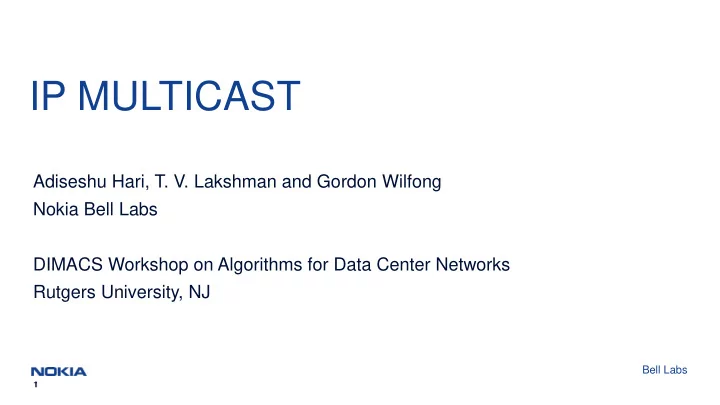

IP MULTICAST Adiseshu Hari, T. V. Lakshman and Gordon Wilfong Nokia Bell Labs DIMACS Workshop on Algorithms for Data Center Networks Rutgers University, NJ Bell Labs 1 1
Why is IP Multicast not deployed in public networks? • Denial-of-Service (DoS) attack amplification • Complex Control Plane • Large Forwarding state - Non aggregable Multicast state flow Multicast data flow Multicast control plane Multicast data plane Bell Labs 2 Nokia 2017
Can SDN help with Multicast? • Denial-of-Service (DoS) attack amplification • Control state • Forwarding state Multicast state flow Multicast data flow Multicast SDN Controller Multicast SDN switch Bell Labs 3 Nokia 2017
Can we eliminate multicast forwarding state in SDN? • Eliminate unicast forwarding state in SDN: - Path Switching: per-flow routing without per-flow state - New data path suitable for SW switches and programmable packet processors - Encode path in the packet headers - DIMACS 2016 Bell Labs 4 Nokia 2017
Eliminating unicast forwarding state in SDN using Path Switching SDN Controller Bell Labs 5 Nokia 2017
Can we eliminate multicast forwarding state in SDN? Can we extend Path Switching to encode multicast paths? Can we create an efficient encoding of a multicast path? No blowup in packet size (e.g. using bitmaps) No blowup in storage state (e.g,. encode each multicast tree by a unique identifier) Bell Labs 6 Nokia 2017
Can we reduce multicast forwarding state in SDN? • Unicast Branching (UB) - Use branching nodes in the network to replicate unicast flows. - Use SDN Flow Table at ingress and egress - Use SDN Group Table at branching nodes • Reduces multicast forwarding state from linear to sublinear in number of forwarding nodes Bell Labs 7 Nokia 2017
Unicast Branching (UB) Reference Diagram Central Controller Branching Nodes With Group Tables Transit Switches First Hop Switches First Hop Switches Endpoints Endpoints Bell Labs 8
Reducing multicast forwarding state in SDN using Unicast Branching (UB) UB state flow UB data flow UB SDN Controller Unicast switch Ingress, Egress, Branching SDN switch Bell Labs 9 Nokia 2017
Added advantages of Unicast Branching (UB) • Tunable knob to switch between unicast replication and full multicast • Allows for an NFV based implementation • Allows Traffic Engineered branches - Fast Reroute, Per branch QoS • Works at all protocol layers – protocol agnostic - Ethernet, IP, MPLS • Enables unicast only protocols like Segment Routing and TCP to be multicast capable* - HTTP Adaptive Streaming multicast - Efficient content caches • Enables Policy Based Multicast * Requires stateful NFV elements, not just SDN switches for branching points Bell Labs 10 Nokia 2017
Policy Based Multicast • Policy based networking: Rules for non default routing - Geofencing - QoS - Membership filtering • UB enables Policy Based Multicast - Number, location and type of branching nodes Bell Labs 11 Nokia 2017
Where are the Algorithms? Bell Labs 12 Nokia 2017
Building Efficient Policy Based Multicast Trees • Problem 1 definition: Given an ingress node, a set of egress nodes and a set of branching nodes, build an “optimal” - multicast tree. What is “optimal” - - Usual definition is based on link cost. - Steiner tree problem (NP-complete) Bell Labs 13 Nokia 2017
Building Multicast Trees using UB – Major Issue • UB based multicast tree is not a tree!!! It is a “configuration” - • Cannot apply Steiner tree approximation solutions directly. • Problem: How to create minimum cost configurations? r 2 b r G r 1 Bell Labs 14 Nokia 2017
Transformation to Steiner tree problem on H Define : • Edge-weighted graph H = (O,E). O is set of branching nodes (including terminals) e=(b,b’) ∊ O, w(e) = length shortest path containing no internal O nodes • r r 2 2 5 b b 2 r r 4 H 5 G r r 1 1 Theorem: Minimum cost configuration problem in G is equivalent to Steiner tree problem in H Bell Labs 15
Minimum cost configuration problem Theorem: There is a polynomial-time 1.39-approximation algorithm for min cost configuration problem. [BGRS10] Theorem: The minimum cost configuration problem is APX-hard. Proof: Follows from APX-hardness of Steiner problem for complete graphs with weights 1 and 2. [BP89] Bell Labs 16
Problem 2: Minimize branching nodes • Problem 1: Minimize cost given a set of branching nodes . MIN COST PROBLEM • Problem 2: Minimize number of branching nodes given a fixed cost. MIN BRANCHING PROBLEM Bell Labs 17 Nokia 2017
Min Branching Problem • For a subset X of the transit nodes, let C X be the minimum cost valid configuration using X as the set of extra branching nodes. • We are given a graph G = (V, E), a multicast demand d = (r, r1, r2,..., rt), a bound k and an attainable cost c. • Does there exists a branching set X with least cost valid configuration C X satisfying d where X <= k and cost(C X ) <= c. Bell Labs 18 Does anybody
Min Branching Problem Theorem: This problem is NP-complete. Proof: Follows from a construction using Set Cover. Corollary: For this problem the best possible approximation is ≈ ln n . Proof: Follows from bounds for Set Cover. Bell Labs 19 Does anybody
Theorem: Min Branching is NP-complete r , 1 demand r r , , r n C r , r , r , r c e f 1 1 C C 1 m C r , r , r , r m a b e n r r r r r r r b c e a 1 f n Bell Labs 20
Policy Driven Software Defined Multicast Using Efficient Selection of Unicast Branching Points • Conclusion: - Unicast Branching based multicast provides for efficient, policy driven Software Defined Multicast. Bell Labs 21 Nokia 2017
Recommend
More recommend